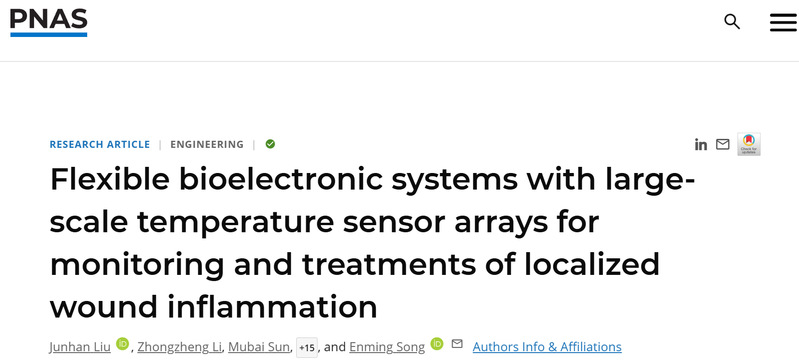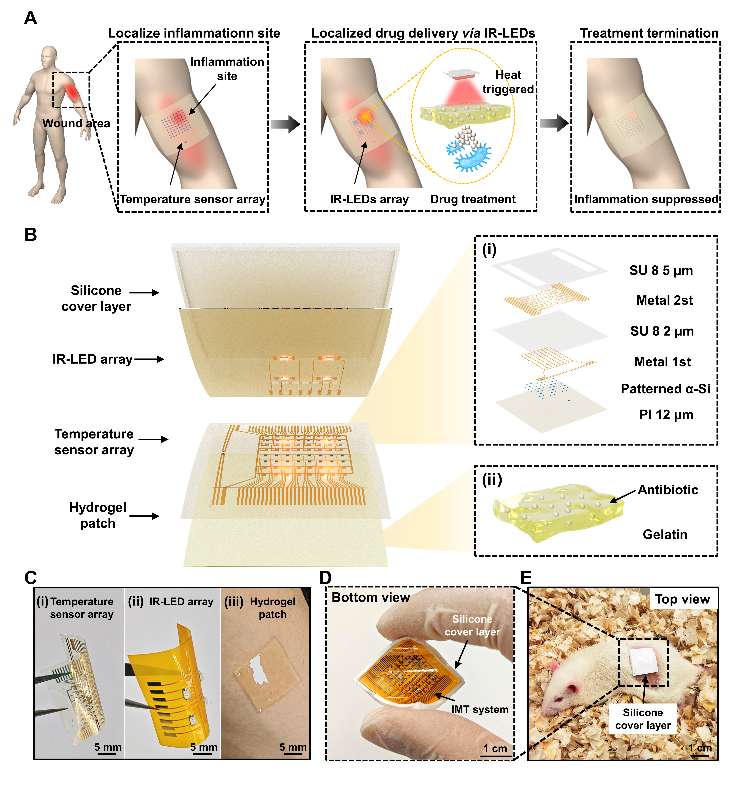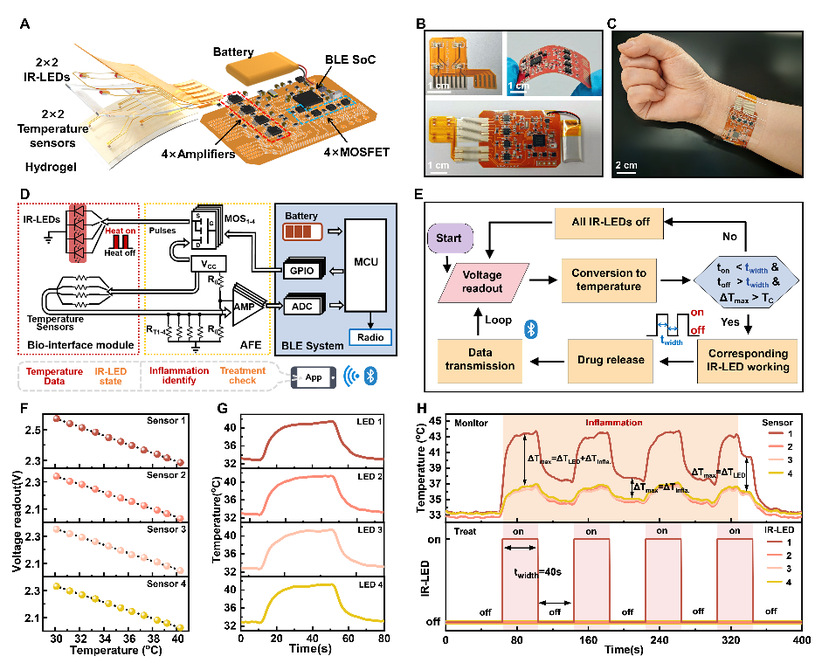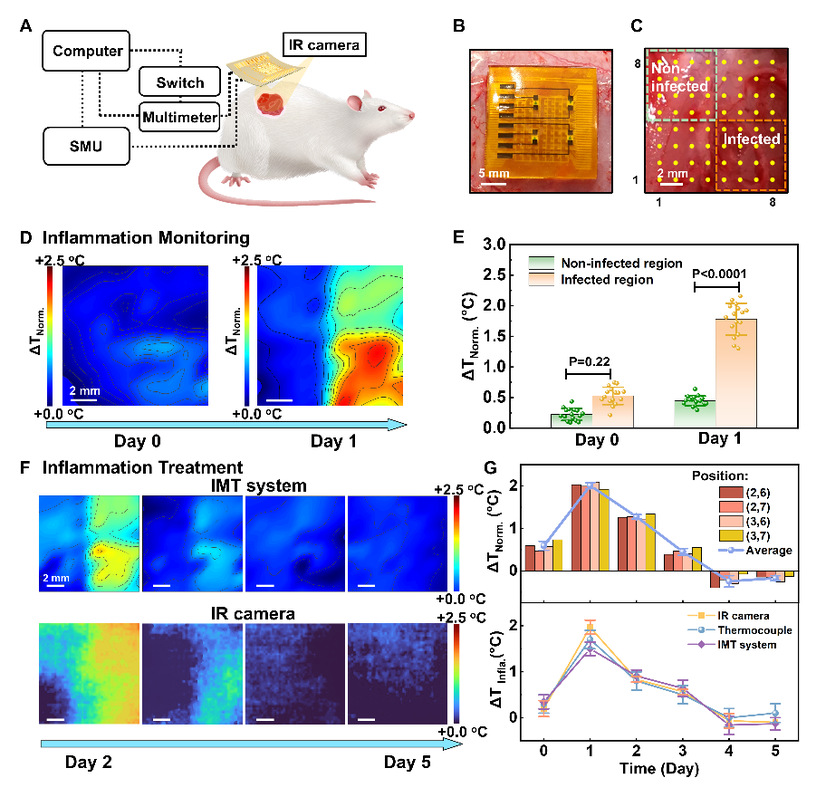快速伤口组织原位评估和管理的技术,在生物研究和临床医疗领域具有广泛的应用前景。可穿戴/植入式系统能够提供诊断信息,跟踪愈合反应,并在各种炎症条件下对任何轻微却具有临床意义的病变做出及时的反应。然而,目前的方法通常仅能提供有限的传感点位和较低的空间分辨率(厘米),难以覆盖大面积的宏观伤口区域,从而限制了其在大尺度范围内进行精确生物体时空映射的应用。此外,理想的闭环伤口管理设计应具备无线控制、远程数据捕获与分析功能,并能够在局部炎症发生时自动激活治疗过程。
近日,复旦大学材料科学系与智慧纳米机器人与纳米系统国际研究院梅永丰教授/宋恩名青年研究员团队提出一种可扩展的柔性保形器件平台(IMT),集成了硅薄膜温度传感器阵列、红外发光二极管矩阵和载药水凝胶贴片,用于监测生物体伤口组织的空间炎症分布并提供药物局域定位治疗,为临床应用和居家医疗中伤口组织的持续监测与治疗反馈提供了解决方案。相关研究成果以“Flexible bioelectronic systems with large-scale temperature sensor arrays for monitoring and treatments of localized wound inflammation”为题发表于PNAS。

研究团队提出监测-治疗-康复一体式的日常伤口管理策略,采取紧凑贴片式设计堆叠载药水凝胶层、规模化硅基温度传感器阵列与红外发光二极管矩阵。材料选取与结构设计确保了IMT贴片与生物体的紧密保形贴附。对各功能层的性能表征表明,非晶硅温度传感单元具备高灵敏度(TCR:-2.25%),高空间分辨率(亚毫米)和优异的稳定性(30天内无信号漂移)。载药水凝胶在红外发光二极管的热量触发下,完成三螺旋的构象转变,释药速度提升了两个数量级。

图1. 用于创口诊疗一体化的亚毫米精度微电极阵列与光控载药系统展示。
研究团队开发了与其匹配的智能无线自动控制模块,在无人为干预的条件下自动处理炎症温度数据并进行释药反馈操作,为日常伤口炎症定位与治疗提供了可行的方案。基于此,该IMT系统可实现亚毫米级别精度的炎症定位与监测、无线数据传输和自动化治疗功能的智能伤口管理系统,在闭环伤口管理的日常监测场景中具有关键优势。

图2. 该系统可实现无线蓝牙模块传输(监测)与远程控制释药(治疗)。
在动物实验过程中,研究团队在大鼠伤口验证了局域炎症监测与治疗的功能。伤口局部感染造模后,短期内观察到感染区域存在显著的温度上升,对应于炎症加剧。释药完成后的数日,伤口范围内的温度场分布逐渐归于均一,代表炎症的缓解直至消失。同时,该系统对伤口组织的组织学和免疫组化分析显示,经过IMT治疗的伤口具有更快的回复速率和更低的炎症水平。生物相容性实验结果中没有观察到明显的生物排异反应。

图3. 动物实验结果证明有效表征炎症分布、并实现定点给药与消炎。
综上,本工作确立了一种材料设计、设备结构和系统集成的方案,用于构建具备炎症定位和靶向治疗功能的生物电子界面,以实现闭环伤口管理。系统性的器件表征揭示了传感器/执行器在热性能、电子性能和抗菌性能方面的特性,详细的模拟和实验突出显示了其热成像的能力。进一步的体内实验展示了其在生物体上的有效应用,成功实现了诊断与治疗的整合,并观察到组织学恢复情况。为了在临床应用中更具可行性和可操作性。更先进的版本集成有柔性电路硬件设计,用于自动操控和无线数据传输。这些结论表明这是一种具备潜力的独特方法,从时间和空间两个维度识别和管理伤口炎症。展望未来,这些策略有望扩展到可实施的电子/光电子设备平台,为器官和神经系统研究提供有价值的工具。
本论文第一作者为博士生刘俊含,梅永丰教授与宋恩名青年研究员为论文的通讯作者。该工作得到了国家科技创新2030-脑科学与类脑研究重大专项(青年科学家)、国家自然科学基金委项目的资助。
文章信息:
Junhan Liu, Zhongzheng Li, Mubai Sun, Yongfeng Mei*, Enming Song* et. al., Flexible bioelectronic systems with large-scale temperature sensor arrays for monitoring and treatments of localized wound inflammation, Proceedings of the National Academy of Sciences of the United States of America, 2024, 121 (49), e2412423121,
文章链接:
https://www.pnas.org/doi/10.1073/pnas.2412423121
Flexible bioelectronic systems with large-scale temperature sensor arrays for monitoring and treatments of localized wound inflammation
Continuous monitoring and closed-loop therapy of soft wound tissues is of particular interest in biomedical research and clinical practices. An important focus is on the development of implantable bioelectronics that can measure time-dependent temperature distribution related to localized inflammation over large areas of wound and offer in situ treatment. Existing approaches such as thermometers/thermocouples provide limited spatial resolution, inapplicable to a wearable/implantable format. Here, we report a conformal, scalable device package that integrates a flexible amorphous silicon–based temperature sensor array and drug-loaded hydrogel for the healing process. This system can enable the spatial temperature mapping at submillimeter resolution and high sensitivity of 0.1 °C, for dynamically localizing the inflammation regions associated with temperature change, automatically followed with heat-triggered drug delivery from hydrogel triggered by wearable infrared light-emitting-diodes. We establish the operational principles experimentally and computationally and evaluate system functionalities with a wide range of targets including live animal models and human subjects. As an example of medical utility, this system can yield closed-loop monitoring/treatments by tracking of temperature distribution over wound areas of live rats, in designs that can be integrated with automated wireless control. These findings create broad utilities of these platforms for clinical diagnosis and advanced therapy for wound healthcare.
Article information:
Junhan Liu, Zhongzheng Li, Mubai Sun, Yongfeng Mei*, Enming Song* et. al., Flexible bioelectronic systems with large-scale temperature sensor arrays for monitoring and treatments of localized wound inflammation, Proceedings of the National Academy of Sciences of the United States of America, 2024, 121 (49), e2412423121,
Article link:
https://www.pnas.org/doi/10.1073/pnas.2412423121
